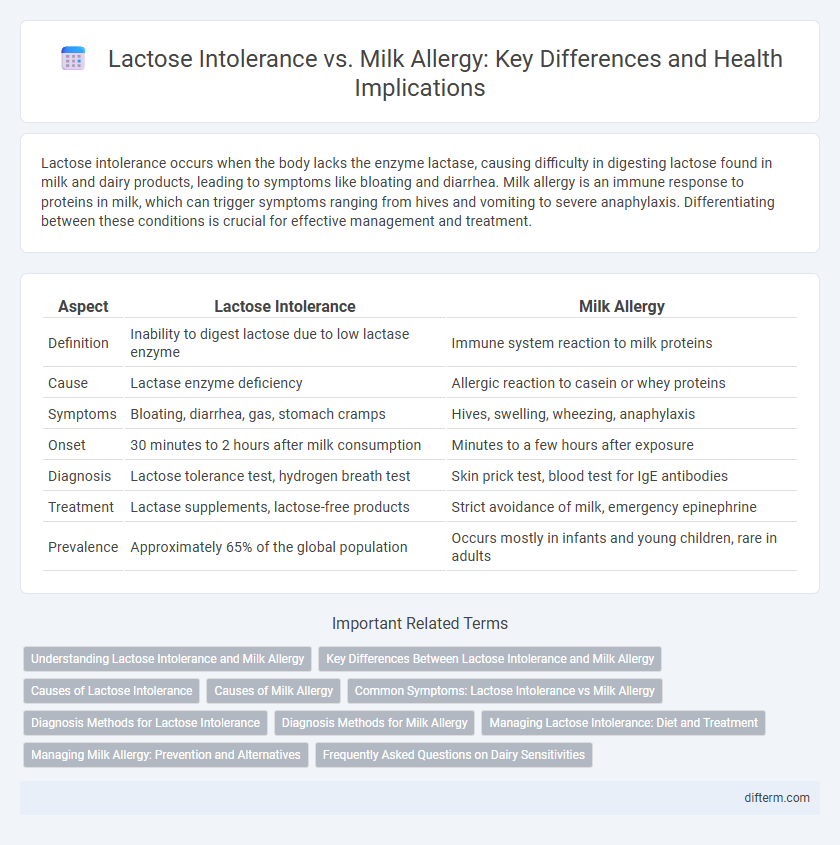Lactose intolerance occurs when the body lacks the enzyme lactase, causing difficulty in digesting lactose found in milk and dairy products, leading to symptoms like bloating and diarrhea. Milk allergy is an immune response to proteins in milk, which can trigger symptoms ranging from hives and vomiting to severe anaphylaxis. Differentiating between these conditions is crucial for effective management and treatment.
Table of Comparison
| Aspect | Lactose Intolerance | Milk Allergy |
|---|---|---|
| Definition | Inability to digest lactose due to low lactase enzyme | Immune system reaction to milk proteins |
| Cause | Lactase enzyme deficiency | Allergic reaction to casein or whey proteins |
| Symptoms | Bloating, diarrhea, gas, stomach cramps | Hives, swelling, wheezing, anaphylaxis |
| Onset | 30 minutes to 2 hours after milk consumption | Minutes to a few hours after exposure |
| Diagnosis | Lactose tolerance test, hydrogen breath test | Skin prick test, blood test for IgE antibodies |
| Treatment | Lactase supplements, lactose-free products | Strict avoidance of milk, emergency epinephrine |
| Prevalence | Approximately 65% of the global population | Occurs mostly in infants and young children, rare in adults |
Understanding Lactose Intolerance and Milk Allergy
Lactose intolerance results from the body's inability to produce enough lactase enzyme, leading to difficulty digesting lactose found in dairy products and causing symptoms like bloating, diarrhea, and gas. Milk allergy involves an immune response to milk proteins such as casein or whey, triggering symptoms that can range from hives and wheezing to life-threatening anaphylaxis. Accurate diagnosis through lactose tolerance tests or allergy testing is essential for effective management and dietary adjustments.
Key Differences Between Lactose Intolerance and Milk Allergy
Lactose intolerance is caused by the body's inability to digest lactose due to lactase enzyme deficiency, leading to symptoms like bloating, diarrhea, and abdominal pain after consuming dairy products. Milk allergy involves an immune response to milk proteins such as casein or whey, triggering symptoms ranging from hives and wheezing to anaphylaxis. Unlike lactose intolerance, milk allergy requires strict dairy avoidance and medical attention, as it can be life-threatening.
Causes of Lactose Intolerance
Lactose intolerance is caused by a deficiency of lactase, the enzyme responsible for breaking down lactose in the small intestine, leading to gastrointestinal symptoms when dairy is consumed. Unlike milk allergy, which is an immune response to milk proteins such as casein and whey, lactose intolerance results from the body's inability to digest sugar rather than an allergic reaction. Genetic factors, aging, and certain intestinal diseases can reduce lactase production, triggering lactose intolerance symptoms.
Causes of Milk Allergy
Milk allergy is caused by an immune system reaction to one or more proteins found in cow's milk, primarily casein and whey. When the body mistakenly identifies these proteins as harmful, it triggers an allergic response that can include hives, vomiting, or even anaphylaxis. Unlike lactose intolerance, which is due to enzyme deficiency, milk allergy involves the activation of immune cells such as IgE antibodies.
Common Symptoms: Lactose Intolerance vs Milk Allergy
Lactose intolerance commonly causes digestive symptoms such as bloating, diarrhea, and gas after consuming dairy products due to the body's inability to digest lactose. Milk allergy triggers immune responses including hives, wheezing, vomiting, and in severe cases, anaphylaxis, as the body reacts to milk proteins. Differentiating symptoms is crucial for proper diagnosis and management, with lactose intolerance affecting the digestive system and milk allergy involving the immune system.
Diagnosis Methods for Lactose Intolerance
Lactose intolerance diagnosis primarily involves the hydrogen breath test, which measures hydrogen levels in the breath after lactose consumption to detect malabsorption. Another common method is the lactose tolerance blood test, assessing blood glucose rise following lactose ingestion to indicate digestion efficiency. Genetic testing can identify specific gene variants related to lactase persistence or non-persistence, supporting diagnosis when combined with clinical symptoms.
Diagnosis Methods for Milk Allergy
Milk allergy diagnosis involves skin prick tests (SPT) and serum-specific IgE blood tests to identify allergic reactions to milk proteins. Oral food challenges conducted under medical supervision confirm the allergy by monitoring symptoms after milk ingestion. Accurate diagnosis distinguishes milk allergy from lactose intolerance, guiding appropriate dietary management.
Managing Lactose Intolerance: Diet and Treatment
Managing lactose intolerance involves limiting or avoiding dairy products containing lactose while incorporating lactose-free alternatives such as almond, soy, or lactose-free milk. Enzyme supplements containing lactase can aid digestion and reduce symptoms like bloating, diarrhea, and gas. Consulting a healthcare provider ensures proper diagnosis and personalized dietary strategies to maintain nutritional balance, especially calcium and vitamin D intake.
Managing Milk Allergy: Prevention and Alternatives
Managing milk allergy requires strict avoidance of all dairy products and careful label reading to prevent allergic reactions. Alternative nutritional sources include fortified plant-based milks like almond, soy, or oat, which provide essential calcium and vitamin D. Emergency preparedness involves carrying prescribed epinephrine auto-injectors and consulting healthcare providers for personalized management plans.
Frequently Asked Questions on Dairy Sensitivities
Lactose intolerance occurs due to the body's inability to digest lactose, a sugar found in milk, leading to symptoms like bloating, diarrhea, and abdominal pain shortly after dairy consumption. Milk allergy involves an immune response to milk proteins such as casein or whey, potentially causing hives, swelling, or anaphylaxis, which requires immediate medical attention. Dairy sensitivities frequently prompt questions about diagnosis methods, symptom differentiation, and dietary management to ensure individual health and safety.
Lactose intolerance vs Milk allergy Infographic

 difterm.com
difterm.com